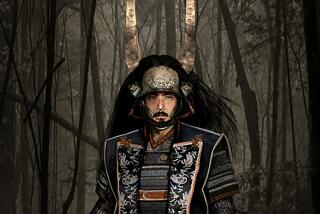Modernism, Japanese style
- Share via
Alternately subtle and flamboyant, hearty and austere, literary and visceral, the traditional dance idioms of Japan offer contemporary artists a vast array of experiences and vocabularies to adopt, adapt, evoke or rebel against.
Over the weekend, Southland stages featured hybrid Japanese modernism from two sides of the Pacific: the final installment of Oguri’s “Height of Sky” project in Hollywood and Nishizaki Midori’s dance drama “Yaobikuni” in Westwood.
Trained in the primal neo-Expressionist butoh idiom, locally based dancer-choreographer Oguri spent more than two months in the desert of Joshua Tree National Park in 2001 and 2002, exploring dance as a response to the environment.
At the Barnsdall Park Junior Arts Center and Gallery Theater on Saturday, an exhibit of photographs and a video screening documented his journey, while a meditative hourlong solo conveyed his feelings of connection to the Earth.
After walking through narrow canvas corridors into a circular performance space with more than 150 transparent plastic bags filled with water hanging from the ceiling, the “Height of Sky” audience found Oguri shedding most of his clothing and carving deep furrows into the salt on the floor as he shuffled toward the far wall.
Bell tones and shuffling/rustling noises supplied by Jean Copeland floated through the wall, and lighting changes suggested the passage of time, as Oguri endowed incremental changes of position with overpowering intensity.
At one point, he seemed to be reinventing the art of dance, stamping in near darkness as a kind of signal to anyone or anything out there that he existed. And at the very end, he became another creature entirely, moving from a standing position to a backbend so extreme that his knees were facing forward and his head (upside down) backward.
Nothing this unsparing or original distinguished the speeded-up, watered-down version of butoh in “Yaobikuni,” which also offered a brief reference to Noh, lots of influences from Kabuki and jaunty folk dance ensembles that seemed intended to brighten a downbeat narrative about the curse of immortality.
The 90-minute performance boasted a large, disciplined Tokyo-based company of actors, dancers and musicians, a stage full of bamboo foliage, plus special effects galore.
However, the spotlight always belonged to Midori herself, a performer of considerable skill but with an unfortunate addiction to pointless, picturesque changes of costume and melodramatic lurch-and-stagger pantomime.
In 1989, when her piece was new, it might have seemed innovative to have a quasi-Kabuki heroine menaced by pseudo-butoh demons. But audiences have seen too much genuine Kabuki and butoh since then to be impressed by the lightweight approximations confronting one another here.
Moreover, the so-called contemporary-dance sequences meandered expressively and lacked the focus on steps that would have helped offset all that pantomime.
Finally, it didn’t help that the production’s smoke machines set off strobes and sirens throughout Royce Hall on Friday, causing an unscheduled intermission while the fire marshal checked everything out.
Recorded music in a number of styles accompanied the dancing, along with occasional invigorating performances by Hanaki Hisami on taiko, a deep-toned drum; and Handa Junko on biwa, a twangy lute. Suzuki Kanichiro directed.
More to Read
The biggest entertainment stories
Get our big stories about Hollywood, film, television, music, arts, culture and more right in your inbox as soon as they publish.
You may occasionally receive promotional content from the Los Angeles Times.










